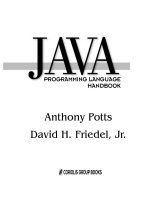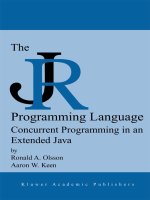Generics in the Java Programming Language
Bạn đang xem bản rút gọn của tài liệu. Xem và tải ngay bản đầy đủ của tài liệu tại đây (69.56 KB, 23 trang )
Generics in the Java Programming Language
Gilad Bracha
March 9, 2004
Contents
1 Introduction 2
2 Defining Simple Generics 3
3 Generics and Subtyping 4
4 Wildcards 5
4.1 Bounded Wildcards . . . . . . . . . . . . . . . . . . . . . . . . . . . 6
5 Generic Methods 7
6 Interoperating with Legacy Code 10
6.1 Using Legacy Code in Generic Code . . . . . . . . . . . . . . . . . . 10
6.2 Erasure and Translation . . . . . . . . . . . . . . . . . . . . . . . . . 12
6.3 Using Generic Code in Legacy Code . . . . . . . . . . . . . . . . . . 13
7 The Fine Print 14
7.1 A Generic Class is Shared by all its Invocations . . . . . . . . . . . . 14
7.2 Casts and InstanceOf . . . . . . . . . . . . . . . . . . . . . . . . . . 14
7.3 Arrays . . . . . . . . . . . . . . . . . . . . . . . . . . . . . . . . . . 15
8 Class Literals as Run-time Type Tokens 16
9 More Fun with Wildcards 17
9.1 Wildcard Capture . . . . . . . . . . . . . . . . . . . . . . . . . . . . 20
10 Converting Legacy Code to Use Generics 20
11 Acknowledgements 23
1
1 Introduction
JDK 1.5 introduces several extensions to the Java programming language. One of these
is the introduction of generics.
This tutorial is aimed at introducing you to generics. You may be familiar with
similar constructs from other languages, most notably C++ templates. If so, you’ll soon
see that there are both similarities and important differences. If you are not familiar
with look-a-alike constructs from elsewhere, all the better; you can start afresh, without
unlearning any misconceptions.
Generics allow you to abstract over types. The most common examples are con-
tainer types, such as those in the Collection hierarchy.
Here is a typical usage of that sort:
List myIntList = new LinkedList(); // 1
myIntList.add(new Integer(0)); // 2
Integer x = (Integer) myIntList.iterator().next(); // 3
The cast on line 3 is slightly annoying. Typically, the programmer knows what
kind of data has been placed into a particular list. However, the cast is essential. The
compiler can only guarantee that an Object will be returned by the iterator. To ensure
the assignment to a variable of type Integer is type safe, the cast is required.
Of course, the cast not only introduces clutter. It also introduces the possibility of
a run time error, since the programmer might be mistaken.
What if programmers could actually express their intent, and mark a list as being
restricted to contain a particular data type? This is the core idea behind generics. Here
is a version of the program fragment given above using generics:
List<Integer> myIntList = new LinkedList<Integer>(); // 1’
myIntList.add(new Integer(0)); //2’
Integer x = myIntList.iterator().next(); // 3’
Notice the type declaration for the variable myIntList. It specifies that this is not
just an arbitrary List, but a List of Integer, written List<Integer>. We say that List is
a generic interface that takes a type parameter - in this case, Integer. We also specify
a type parameter when creating the list object.
The other thing to pay attention to is that the cast is gone on line 3’.
Now, you might think that all we’ve accomplished is to move the clutter around.
Instead of a cast to Integer on line 3, we have Integer as a type parameter on line 1’.
However, there is a very big difference here. The compiler can now check the type
correctness of the program at compile-time. When we say that myIntList is declared
with type List<Integer>, this tells us something about the variable myIntList, which
holds true wherever and whenever it is used, and the compiler will guarantee it. In
contrast, the cast tells us something the programmer thinks is true at a single point in
the code.
The net effect, especially in large programs, is improved readability and robustness.
2
2 Defining Simple Generics
Here is a small excerpt from the definitions of the interfaces List and Iterator in pack-
age java.util:
public interface List<E> {
void add(E x);
Iterator<E> iterator();
}
public interface Iterator<E> {
E next();
boolean hasNext();
}
This should all be familiar, except for the stuff in angle brackets. Those are the
declarations of the formal type parameters of the interfaces List and Iterator.
Type parameters can be used throughout the generic declaration, pretty much where
you would use ordinary types (though there are some important restrictions; see section
7).
In the introduction, we saw invocations of the generic type declaration List, such
as List<Integer>. In the invocation (usually called a parameterized type), all occur-
rences of the formal type parameter (E in this case) are replaced by the actual type
argument (in this case, Integer).
You might imagine that List<Integer> stands for a version of List where E has
been uniformly replaced by Integer:
public interface IntegerList {
void add(Integer x)
Iterator<Integer> iterator();
}
This intuition can be helpful, but it’s also misleading.
It is helpful, because the parameterized type List<Integer> does indeed have
methods that look just like this expansion.
It is misleading, because the declaration of a generic is never actually expanded in
this way. There aren’t multiple copies of the code: not in source, not in binary, not on
disk and not in memory. If you are a C++ programmer, you’ll understand that this is
very different than a C++ template.
A generic type declaration is compiled once and for all, and turned into a single
class file, just like an ordinary class or interface declaration.
Type parameters are analogous to the ordinary parameters used in methods or con-
structors. Much like a method has formal value parameters that describe the kinds of
values it operates on, a generic declaration has formal type parameters. When a method
is invoked, actual arguments are substituted for the formal parameters, and the method
body is evaluated. When a generic declaration is invoked, the actual type arguments
are substituted for the formal type parameters.
A note on naming conventions. We recommend that you use pithy (single character
if possible) yet evocative names for formal type parameters. It’s best to avoid lower
3
case characters in those names, making it easy to distinguish formal type parameters
from ordinary classes and interfaces. Many container types use E, for element, as in
the examples above. We’ll see some additional conventions in later examples.
3 Generics and Subtyping
Let’s test our understanding of generics. Is the following code snippet legal?
List<String> ls = new ArrayList<String>(); //1
List<Object> lo = ls; //2
Line 1 is certainly legal. The trickier part of the question is line 2. This boils down
to the question: is a List of String a List of Object. Most people’s instinct is to answer:
“sure!”.
Well, take a look at the next few lines:
lo.add(new Object()); // 3
String s = ls.get(0); // 4: attempts to assign an Object to a String!
Here we’ve aliased ls and lo. Accessing ls, a list of String, through the alias lo, we
can insert arbitrary objects into it. As a result ls does not hold just Strings anymore,
and when we try and get something out of it, we get a rude surprise.
The Java compiler will prevent this from happening of course. Line 2 will cause a
compile time error.
In general, if Foo is a subtype (subclass or subinterface) of Bar, and G is some
generic type declaration, it is not the case that G<Foo> is a subtype of G<Bar>.
This is probably the hardest thing you need to learn about generics, because it goes
against our deeply held intuitions.
The problem with that intuition is that it assumes that collections don’t change.
Our instinct takes these things to be immutable.
For example, if the department of motor vehicles supplies a list of drivers to the cen-
sus bureau, this seems reasonable. We think that a List<Driver> is a List<Person>,
assuming that Driver is a subtype of Person. In fact, what is being passed is a copy
of the registry of drivers. Otherwise, the census bureau could add new people who are
not drivers into the list, corrupting the DMV’s records.
In order to cope with this sort of situation, it’s useful to consider more flexible
generic types. The rules we’ve seen so far are quite restrictive.
4
4 Wildcards
Consider the problem of writing a routine that prints out all the elements in a collection.
Here’s how you might write it in an older version of the language:
void printCollection(Collection c) {
Iterator i = c.iterator();
for (k = 0; k < c.size(); k++) {
System.out.println(i.next());
}}
And here is a naive attempt at writing it using generics (and the new for loop syn-
tax):
void printCollection(Collection<Object> c) {
for (Object e : c) {
System.out.println(e);
}}
The problem is that this new version is much less useful than the old one. Whereas
the old code could be called with any kind of collection as a parameter, the new code
only takes Collection<Object>, which, as we’ve just demonstrated, is not a supertype
of all kinds of collections!
So what is the supertype of all kinds of collections? It’s written Collection<?>
(pronounced “collection of unknown”) , that is, a collection whose element type matches
anything. It’s called a wildcard type for obvious reasons. We can write:
void printCollection(Collection<?> c) {
for (Object e : c) {
System.out.println(e);
}}
and now, we can call it with any type of collection. Notice that inside printCollec-
tion(), we can still read elements from c and give them type Object. This is always
safe, since whatever the actual type of the collection, it does contain objects. It isn’t
safe to add arbitrary objects to it however:
Collection<?> c = new ArrayList<String>();
c.add(new Object()); // compile time error
Since we don’t know what the element type of c stands for, we cannot add objects
to it. The add() method takes arguments of type E, the element type of the collection.
When the actual type parameter is ?, it stands for some unknown type. Any parameter
we pass to add would have to be a subtype of this unknown type. Since we don’t know
what type that is, we cannot pass anything in. The sole exception is null, which is a
member of every type.
On the other hand, given a List<?>, we can call get() and make use of the result.
The result type is an unknown type, but we always know that it is an object. It is
5
therefore safe to assign the result of get() to a variable of type Object or pass it as a
parameter where the type Object is expected.
4.1 Bounded Wildcards
Consider a simple drawing application that can draw shapes such as rectangles and cir-
cles. To represent these shapes within the program, you could define a class hierarchy
such as this:
public abstract class Shape {
public abstract void draw(Canvas c);
}
public class Circle extends Shape {
private int x, y, radius;
public void draw(Canvas c) { ... }
}
public class Rectangle extends Shape {
private int x, y, width, height;
public void draw(Canvas c) { ... }
}
These classes can be drawn on a canvas:
public class Canvas {
public void draw(Shape s) {
s.draw(this);
}
}
Any drawing will typically contain a number of shapes. Assuming that they are
represented as a list, it would be convenient to have a method in Canvas that draws
them all:
public void drawAll(List<Shape> shapes) {
for (Shape s: shapes) {
s.draw(this);
}
}
Now, the type rules say that drawAll() can only be called on lists of exactly Shape:
it cannot, for instance, be called on a List<Circle>. That is unfortunate, since all
the method does is read shapes from the list, so it could just as well be called on a
List<Circle>. What we really want is for the method to accept a list of any kind of
shape:
public void drawAll(List<? extends Shape> shapes) { ... }
There is a small but very important difference here: we have replaced the type
List<Shape> with List<? extends Shape>. Now drawAll() will accept lists of
any subclass of Shape, so we can now call it on a List<Circle> if we want.
6
List<? extends Shape> is an example of a bounded wildcard. The ? stands
for an unknown type, just like the wildcards we saw earlier. However, in this case, we
know that this unknown type is in fact a subtype of Shape
1
. We say that Shape is the
upper bound of the wildcard.
There is, as usual, a price to be paid for the flexibility of using wildcards. That price
is that it is now illegal to write into shapes in the body of the method. For instance,
this is not allowed:
public void addRectangle(List<? extends Shape> shapes) {
shapes.add(0, new Rectangle()); // compile-time error!
}
You should be able to figure out why the code above is disallowed. The type of
the second parameter to shapes.add() is ? extends Shape - an unknown subtype
of Shape. Since we don’t know what type it is, we don’t know if it is a supertype
of Rectangle; it might or might not be such a supertype, so it isn’t safe to pass a
Rectangle there.
Bounded wildcards are just what one needs to handle the example of the DMV
passing its data to the census bureau. Our example assumes that the data is represented
by mapping from names (represented as strings) to people (represented by reference
types such as Person or its subtypes, such as Driver). Map<K,V> is an example of
a generic type that takes two type arguments, representing the keys and values of the
map.
Again, note the naming convention for formal type parameters - K for keys and V
for values.
public class Census {
public static void
addRegistry(Map<String, ? extends Person> registry) { ...}
}
...
Map<String, Driver> allDrivers = ...;
Census.addRegistry(allDrivers);
5 Generic Methods
Consider writing a method that takes an array of objects and a collection and puts all
objects in the array into the collection.
Here is a first attempt:
static void fromArrayToCollection(Object[] a, Collection<?> c) {
for (Object o : a) {
c.add(o); // compile time error
}}
By now, you will have learned to avoid the beginner’s mistake of trying to use
Collection<Object> as the type of the collection parameter. You may or may not
1
It could be Shape itself, or some subclass; it need not literally extend Shape.
7
have recognized that using Collection<?> isn’t going to work either. Recall that you
cannot just shove objects into a collection of unknown type.
The way to do deal with these problems is to use generic methods. Just like type
declarations, method declarations can be generic - that is, parameterized by one or
more type parameters.
static <T> void fromArrayToCollection(T[] a, Collection<T> c) {
for (T o : a) {
c.add(o); // correct
}}
We can call this method with any kind of collection whose element type is a super-
type of the element type of the array.
Object[] oa = new Object[100];
Collection<Object> co = new ArrayList<Object>();
fromArrayToCollection(oa, co);// T inferred to be Object
String[] sa = new String[100];
Collection<String> cs = new ArrayList<String>();
fromArrayToCollection(sa, cs);// T inferred to be String
fromArrayToCollection(sa, co);// T inferred to be Object
Integer[] ia = new Integer[100];
Float[] fa = new Float[100];
Number[] na = new Number[100];
Collection<Number> cn = new ArrayList<Number>();
fromArrayToCollection(ia, cn);// T inferred to be Number
fromArrayToCollection(fa, cn);// T inferred to be Number
fromArrayToCollection(na, cn);// T inferred to be Number
fromArrayToCollection(na, co);// T inferred to be Object
fromArrayToCollection(na, cs);// compile-time error
Notice that we don’t have to pass an actual type argument to a generic method. The
compiler infers the type argument for us, based on the types of the actual arguments. It
will generally infer the most specific type argument that will make the call type-correct.
One question that arises is: when should I use generic methods, and when should I
use wildcard types? To understand the answer, let’s examine a few methods from the
Collection libraries.
interface Collection<E> {
public boolean containsAll(Collection<?> c);
public boolean addAll(Collection<? extends E> c);
}
We could have used generic methods here instead:
interface Collection<E> {
public <T> boolean containsAll(Collection<T> c);
public <T extends E> boolean addAll(Collection<T> c);
// hey, type variables can have bounds too!
}
8
However, in both containsAll and addAll, the type parameter T is used only once.
The return type doesn’t depend on the type parameter, nor does any other argument
to the method (in this case, there simply is only one argument). This tells us that the
type argument is being used for polymorphism; its only effect is to allow a variety of
actual argument types to be used at different invocation sites. If that is the case, one
should use wildcards. Wildcards are designed to support flexible subtyping, which is
what we’re trying to express here.
Generic methods allow type parameters to be used to express dependencies among
the types of one or more arguments to a method and/or its return type. If there isn’t
such a dependency, a generic method should not be used.
It is possible to use both generic methods and wildcards in tandem. Here is the
method Collections.copy():
class Collections {
public static <T> void copy(List<T> dest, List<? extends T> src){...}
}
Note the dependency between the types of the two parameters. Any object copied
from the source list, src, must be assignable to the element type T of the destination
list, dst. So the element type of src can be any subtype of T - we don’t care which.
The signature of copy expresses the dependency using a type parameter, but uses a
wildcard for the element type of the second parameter.
We could have written the signature for this method another way, without using
wildcards at all:
class Collections {
public static <T, S extends T>
void copy(List<T> dest, List<S> src){...}
}
This is fine, but while the first type parameter is used both in the type of src and
in the bound of the second type parameter, S, S itself is only used once, in the type of
dst - nothing else depends on it. This is a sign that we can replace S with a wildcard.
Using wildcards is clearer and more concise than declaring explicit type parameters,
and should therefore be preferred whenever possible.
Wildcards also have the advantage that they can be used outside of method signa-
tures, as the types of fields, local variables and arrays. Here is an example.
Returning to our shape drawing problem, suppose we want to keep a history of
drawing requests. We can maintain the history in a static variable inside class Shape,
and have drawAll() store its incoming argument into the history field.
static List<List<? extends Shape>> history =
new ArrayList<List<? extends Shape>>();
public void drawAll(List<? extends Shape> shapes) {
history.addLast(shapes);
for (Shape s: shapes) {
s.draw(this);
}}
9









